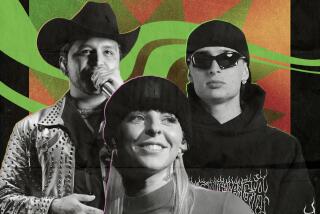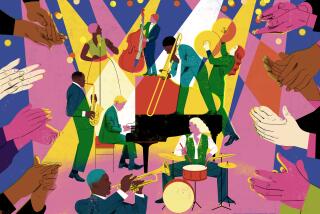JAZZ REVIEW : Veteran of Swing’s Seven Strings Sing : Guitarist George Van Eps Entrances the Mucho Gusto Audience With Soft Tufts of Sound
- Share via
COSTA MESA — The innovative George Van Eps remains one of the wonders of the guitar world.
Holding forth with fellow guitarist Ron Eschete on Thursday at Mucho Gusto, the 78-year-old inventor of the seven-string guitar--whose extra string allows him to concoct his own bass-line accompaniment--entranced his audience and received enthusiastic ovations after each rendition.
A Swing-era veteran, Van Eps makes his guitar sing, his hands producing succulent, soft tufts of sound that waft gently through the air like the impressionistic, multicolored clouds of a Monet painting.
Van Eps caresses a tune’s melody, giving it prominence in a performance. At the same time, by almost exclusively employing chords to deliver melody, he surrounds a song’s theme with complementary, auxiliary tones, giving his offerings an expansive subtlety.
In his improvised choruses, Huntington Beach resident Van Eps, who has worked with Benny Goodman and Ray Noble, never let a tune’s original theme get far out of earshot, but he displayed that theme ever more sparingly, as if he were playing hide and seek with it. Delicate, lush chords might have a smidgen of the melody, but just as often they didn’t.
Sitting relaxed on a chair, his legs crossed, the guitarist looked very casual in gray slacks, a light-blue shirt with a red tie, a brown Windbreaker and white tennis shoes. Van Eps occasionally turned to single-note lines and, like his chordal efforts, these statements were fluid and smooth, though they had more rhythmic regularity than his chords, which sometimes were bunched together, other times delivered with plenty of space. Dynamically, he was restrained, remaining in the medium-soft to medium-loud range as he delivered his appealing essays of “What’s New,” “Mine” and “I Didn’t Know What Time It Was.”
Eschete was working for the first time with the man he has called “one of my heroes.” And while he also employed a seven-stringed instrument, his playing was in sharp contrast to his partner’s.
For example, Eschete, who provided soft chords as Van Eps rendered a song’s melody, broke loose during his solos, often delivering jack-rabbit fast double-timed statements that twisted and turned like a Grand Prix racer roaring through the streets of Monte Carlo. Van Eps eschewed these rapid bursts, preferring to stay with a tune’s given tempo.
Cole Porter’s “What Is This Thing Called Love?” was one of many highlights of the evening’s two-set performance. Van Eps began the number with his chordal style, and dropped generous re-phrasings of this classic’s well-known theme into his solo. Eschete’s improvisation immediately took a be-bop stance, as he played a few lines from “Hot House,” Tadd Dameron’s 1940s reworking of Porter’s tune. He then dashed off crisp, clean single-note phrases, prancing up his instrument and back down it as seamlessly as Michael Jordan ascends to the rim for a slam dunk, and then gracefully returns to the floor.
Both players were also spotlighted solo, and the complexity of sounds emanating from their distinctive instruments provided a delicious, orchestral flavor. Van Eps roamed over the concise landscape of the Gershwins’ “I Got Rhythm.” He would play bits of the theme, then shift gears and intersperse three or four bass line notes. In his more adventurous moments, Van Eps managed to offer both chords, which were as warm and comforting as a favorite blanket, and bass notes simultaneously.
For his feature, Eschete delivered glances at “I Have Dreamed,” from “The King and I,” as well as “Suicide is Painless: The Theme From ‘MASH’ ” and a few phrases from Jobim’s “Agua de Beber.” His sound was harder and brighter than his cohort’s, and his hands moved faster as blocks of sound careened here and there tastefully, painting a sumptuous aural picture.
Bassist Luther Hughes and drummer John Perett were the other essential elements in this excellent sonic excursion. Perett was demure behind Van Eps, keeping things subtle with gentle cymbal strokes and light drum taps. When Eschete played, he opened up, adding a drive and pulse that fit in perfectly with the guitarist’s more explosive ideas.
Hughes, who always offers strong, intelligent bass lines, was also superlative as a soloist. Usually following Eschete, as on “What Is This,” he delivered statements that had a be-bop sensibility. His lines seemed to inevitably land on the choicest notes, and his facility and rhythmic acuity gave his improvisations a definite pop.
More to Read
The biggest entertainment stories
Get our big stories about Hollywood, film, television, music, arts, culture and more right in your inbox as soon as they publish.
You may occasionally receive promotional content from the Los Angeles Times.










